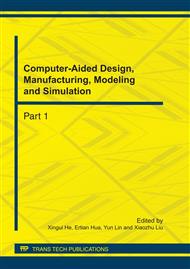p.379
p.386
p.395
p.399
p.404
p.408
p.413
p.418
p.423
The Impact Factors of Numerical Computation to Cavitating Flow
Abstract:
Steady cavity flow of 2-D hydrofoil is simulated by CFD software. The impacts of different cavitation models, turbulence models and wall functions to the numerical simulation results are analyzed. The pressure distributing curve and volume fraction distributing map are obtained through detailed analysis to cavity flow under different cavity number. The analysis results show that those cavitation models simulate the origination and forming process of cavity preferably, which match experiment values closely. However, there are some differences among the results of those different cavitation models in the cavity closing area. The results of RNGmodel and the RSM model are more uniformity with the experiment values, but there is large distinctive between the result of the standard and the experiment values. The results of the standard wall function and the non-equilibrium wall function which have distinction with the experiment values are closed, but the enhanced wall function is the most accurate.
Info:
Periodical:
Pages:
404-407
Citation:
Online since:
August 2011
Authors:
Price:
Сopyright:
© 2011 Trans Tech Publications Ltd. All Rights Reserved
Share:
Citation:


